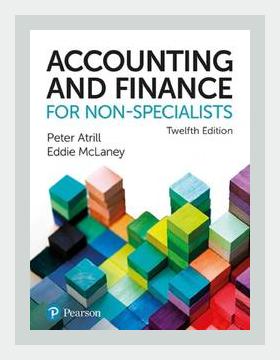Finance and AccountingFinancial Reporting
1. Introduction to Accounting and Finance
– Overview: Peter Atrill introduces the fundamental concepts of accounting and finance, emphasizing their importance in decision-making within businesses.
– Concrete Example: Atrill illustrates how a basic understanding of financial statements can influence business decisions like whether to invest in new machinery or save costs.
– Actionable Advice: Non-specialists should familiarize themselves with basic financial statements (income statement, balance sheet, and cash flow statement) to better understand a company’s financial health.
2. Financial Statements
– Balance Sheet: Provides information on a company’s financial position at a specific point in time.
– Example: Atrill explains how to interpret assets, liabilities, and equity, using a retail company’s balance sheet.
– Actionable Step: Learn to distinguish between current and non-current assets and liabilities to assess liquidity and financial stability.
-
Income Statement: Shows the company’s performance over a period, highlighting revenue and expenses.
- Example: Detailed breakdown of a hypothetical company’s income statement, showcasing various revenue streams and expense categories.
- Actionable Step: Regularly review income statements to monitor profitability trends and identify areas for cost control or revenue enhancement.
-
Cash Flow Statement: Displays cash movements in operating, investing, and financing activities.
- Example: Discussion on the significance of cash flows in a tech start-up and how positive cash flow ensures operational sustainability.
- Actionable Step: Develop a habit of examining cash flow statements to predict potential cash shortages and plan accordingly.
3. Understanding Financial Performance
– Financial Ratios:
– Profitability Ratios: Metrics like gross margin, net profit margin, return on assets.
– Example: Atrill uses an example of a manufacturing firm to explain how profitability ratios indicate efficiency in generating profits.
– Actionable Step: Use profitability ratios to compare your business against industry benchmarks and identify improvement areas.
- **Liquidity Ratios**: Include current and quick ratios to evaluate the ability to meet short-term obligations.
- **Example**: Analysis of a small retailer’s liquidity ratios to understand its ability to handle short-term liabilities.
- **Actionable Step**: Frequently compute liquidity ratios to ensure that the business maintains adequate liquidity.
- **Leverage Ratios**: Assess financial structure and risk, including debt to equity ratio.
- **Example**: Atrill explains how high leverage in a construction firm increases financial risk during economic downturns.
- **Actionable Step**: Monitor leverage ratios to manage and mitigate financial risks associated with borrowing.
4. Financial Planning and Forecasting
– Budgeting: Establishing financial plans for future operations.
– Example: Atrill discusses creating a detailed budget for a small café, including projected sales and expenses.
– Actionable Step: Create annual and monthly budgets to plan for revenue and control costs effectively.
- Forecasting: Predicting future financial conditions based on historical data and market analysis.
- Example: Usage of seasonal sales data to forecast next quarter’s revenue for a clothing store.
- Actionable Step: Utilize historical data and market trends to create realistic financial forecasts to guide business decisions.
5. Costing and Pricing
– Costing Methods: Different methods like absorption costing and marginal costing.
– Example: Comparison of product costs using both methods in a manufacturing context.
– Actionable Step: Choose appropriate costing methods based on the nature of products and industry to ensure accurate product pricing.
- Pricing Strategies: Setting prices based on costs, value, and competition.
- Example: Pricing strategy for a new product line in electronics, considering both production costs and competitive landscape.
- Actionable Step: Implement a pricing strategy that balances cost recovery with competitive positioning to maximize profitability.
6. Investment Appraisal
– Techniques: Methods such as Net Present Value (NPV), Internal Rate of Return (IRR), and Payback Period.
– Example: Assessing a new project using NPV and IRR to determine its feasibility for a software development company.
– Actionable Step: Evaluate potential investments carefully using established appraisal techniques to make informed capital investment decisions.
7. Financing the Business
– Sources of Finance: Various sources like equity financing, debt financing, and internal funds.
– Example: Atrill elaborates on a case study where a bakery chooses between bank loans and issuing new shares for expansion.
– Actionable Step: Analyze the pros and cons of different financing options to choose the most suitable one for your business’s needs.
**
8. Managing Working Capital
– Components: Management of inventory, receivables, and payables.
– Example: Atrill explains cash management in a wholesale business, emphasizing the need to balance receivables and payables for maintaining liquidity.
– Actionable Step**: Implement sound working capital management practices to enhance operational efficiency and ensure sufficient liquidity.
9. Personal Finance and Financial Literacy
– Personal Budgeting and Saving: Importance of financial planning for individuals.
– Example: Atrill discusses how to create a personal budget and the importance of an emergency fund.
– Actionable Step: Develop a personal budget and savings plan to manage personal finances effectively and build financial security.
10. Ethical Considerations in Accounting and Finance
– Ethics and Corporate Governance: Importance of ethical conduct and good governance.
– Example: Atrill highlights a corporate scandal, examining the ethical lapses that led to financial misreporting.
– Actionable Step: Foster a culture of ethics and compliance within your organization to uphold integrity and stakeholder trust.
Conclusion
– Synthesis: Atrill concludes by reiterating the significance of understanding accounting and finance principles for non-specialists. He emphasizes that the knowledge equips individuals with the tools needed to make better financial decisions and contribute effectively to their organizations.
– Final Actionable Advice: Continually update your financial knowledge and skills through ongoing education and practice to remain proficient in understanding and applying financial information.
This structured summary provides an overview of Peter Atrill’s “Accounting and Finance for Non-Specialists,” emphasizing the critical concepts, concrete examples, and actionable steps readers can take to apply the knowledge in practical scenarios.
